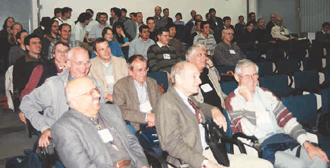by Peter K F Grieder, Elsevier Science, ISBN 0444507108, 190.59 euros/$207.
This book is a remarkable collection of graphs, tables, data and relevant discussions about cosmic-ray physics. As the subtitle, Researcher’s Reference Manual and Data Book, suggests, this is neither a text nor a tutorial, but a valuable resource for scientists in cosmic-ray research and related fields of physics and astrophysics.

In 1984 Peter Grieder of Bern co-wrote, with O C Allkofer of Kiel, a 379-page reference manuscript in the Physics Data series of the Karlsruhe Fach-informations-zentrum (Cosmic Rays on Earth ISBN 03448401) which contained much useful data and has been widely used. Following the death of his co-writer, Grieder has undertaken the daunting task of revising, updating and expanding the work by himself. In view of the significant quantity of new data appearing over the past two decades, this is most appropriate. The result is a comprehensive 1112-page, hardcover volume.
Over the past two decades there has been a significant migration of physicists away from traditional accelerator-based particle physics into particle astrophysics (the current, more erudite, term for cosmic-ray physics). This is perhaps nowhere more apparent than in the formation and direction of major cosmic-ray collaborations by Jim Cronin and Sam Ting, both of whom are Nobel laureates in accelerator-based particle physics.
Mature physicists moving into cosmic-ray-related research from other areas should find this book a particularly valuable source of cosmic-ray knowledge. Of course, it is not intended to replace the role of classic texts such as Thomas Gaisser’s Cosmic Rays and Particle Physics. It covers cosmic rays in the atmosphere, at sea level, underground, underwater and under ice; the primary radiation; solar phenomena; and cosmic-ray history.
In view of the current lively interest in neutrino oscillations and the interpretation of data from Kamioka, Gran Sasso, Homestake, Soudan, Lake Baikal, Antarctica, the Mediterranean Sea and elsewhere, these detailed discussions are highly useful. They may also reflect Grieder’s close connections with the DUMAND and NESTOR underwater detector programmes.
There is a substantive discussion of, and data compilation related to, neutrinos, including both atmospheric and solar neutrinos, the latter as part of the chapter on heliospheric phenomena.
There are also comprehensive chapters in each section devoted to protons, neutrons, heavier nuclei, electrons, positrons and gamma rays (as well as muons and neutrinos). The existing data relevant to major problems and projects currently in progress are well presented. This includes such issues as the primary cosmic-ray spectrum and composition above the GZK cut-off; the confusion concerning the elemental composition in the neighbourhood of the “knee”; questions surrounding the primary antiproton flux; and the limits on primordial antimatter cosmic rays. The author presents this vast accumulation of data without editorial prejudice, so he resists noting which data should be regarded as most reliable and which should be accepted with scepticism.
The latter portion of the book includes useful reference material, such as the “optical, etc properties of water and ice”; parameters of the atmosphere (pressure and temperature versus height above sea level); the “solar elemental abundances”; and tables and graphs of muon dE/dx versus energy in various substances. There is even a full-page table of the many cosmic-ray observing stations around the globe – past and present – together with the altitude and atmospheric overburden of each.
This book is certain to become a standard reference for scholars in the cosmic-ray community, as well as for students and for other physicists and astrophysicists whose activities interface with cosmic-ray issues. Certainly, many of this book’s graphs and tables will be superseded by more precise, forthcoming data from Superkamiokande, Kascade, ACCESS, IceCube, the Pierre Auger project and the many other ongoing and future cosmic-ray research activities, but its value as a reference will surely continue well into the 21st century – until someone else with Grieder’s breadth of comprehension and boundless energy steps forward to undertake another revision.








